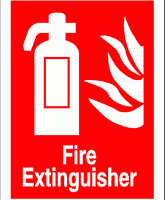A fire sprinkler system consists of a piping network with fire sprinklers extending all over the fire-protected area. There are various types of sprinklers. However, generally speaking, there are two (2) major types of sprinklers: the open type and the closed type fire sprinklers.
Open Fire Sprinklers
In accordance with the definition provided at NFPA 13 (2007 edition), an open fire sprinkler is a water sprinkler that is not equipped with actuators or other heat-responsive elements.
Closed Fire Sprinklers
Closed fire sprinklers typically consist of a glass bulb filled with liquid enclosing the sprinkler. If, as a result of a fire, the air temperature exceeds a specified limit threshold, the expanding liquid bursts the bulb, thus activating the sprinkler.
Picture 1 - Various types of fire sprinklers
In accordance with NFPA 13, the major characteristics that define the ability of a sprinkler are the following:
- Thermal sensitivity: This is measured with the Response Time Index (RTI) and provides an indication of how quickly the thermal element is activated. Fast response fire sprinklers have an RTI index of 50 or less.
- Temperature rating (please refer to table below)
|
Temperature Rating |
Temperature Classification |
Color code |
|
|
0F |
0C |
||
|
135-170 |
57-77 |
Ordinary |
Uncolored or black |
|
175-225 |
79-107 |
Intermediate |
While |
|
250-300 |
121-149 |
High |
Blue |
|
325-375 |
163-191 |
Extra high |
Red |
|
400-475 |
204-246 |
Very extra high |
Green |
|
500-575 |
260-302 |
Ultra high |
Orange |
|
650 |
343 |
Ultra high |
Orange |
Table 1 - Sprinklers temperature classification [source: NFPA 13, 2007 edition]
- Orifice size
- Installation orientation (horizontal, vertical etc)
- Water distribution characteristics
There are various sprinkler systems type configurations. The most commonly used are briefly presented below:
Deluge Sprinkler System
Fire Sprinkler system with open sprinklers that are installed at a piping system which is connected to a water supply through a valve that is opened by the operation of a detection system installed in the same area as the sprinklers. When this valve is activated (opens), water flows into the piping system and is discharged from all fire sprinklers.
Dry Pipe Sprinkler System
A fire sprinkler system using automatic sprinklers that are installed at a piping system containing air or nitrogen under pressure, the release of which allows the water pressure to open a valve (known as a dry pipe valve) and the water then flows into the piping system and out from the opened sprinklers. Dry pipe sprinkler systems are used for protection of equipment that is installed outdoors in freezing environments.
Wet Pipe Sprinkler System
A sprinkler system using automatic fire sprinklers installed along a piping system containing water and connected to a water supply so that water is discharged immediately from sprinklers opened due to heat from a fire.
Picture 3 - Typical layout of dry and wet pipe sprinkler systems
Pre-action Sprinkler System
A sprinkler system using automatic fire sprinklers that are installed along a piping system that contains air that might or might not be under pressure, with a supplemental detection system installed in the same areas as the sprinklers. Preaction systems offer a second level of protection against accidental discharge of water and are mostly used in places where the accidental discharge of water is highly undesirable, for example in museums or historical buildings-monuments.






